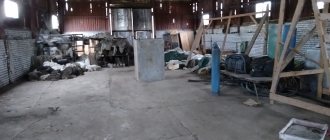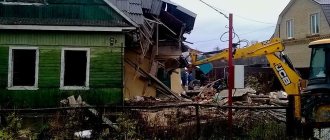The difference between redevelopment and reconstruction
Often these two concepts are confused, therefore, before understanding what reconstruction is, you should understand the difference from redevelopment of a room. They have only one thing in common: unauthorized conduct of such manipulations is fraught with administrative liability. During the reconstruction process, the load-bearing structures are necessarily preserved, but the area may increase or decrease due to additions and superstructures. As for redevelopment, the actual area is preserved, but certain changes may occur inside. As a result, adjustments to the intended use of the premises are allowed. Including their transfer from housing stock to non-residential ones.
Important! Redevelopment may be part of the reconstruction. But to carry out both one and the second manipulation, special permits are required that comply with the norms of the Town Planning Code.
Responsibility for illegal reconstruction
Collecting documents for reconstruction is quite a troublesome task, so some owners of non-residential premises carry out work at their own peril and risk, without obtaining the necessary papers. Their actions fall immediately under two parts of the article of the Code of Administrative Violations (Code of Administrative Violations of the Russian Federation):
- Article 9.5 part 1. It states that for illegal reconstruction, citizens will be fined. Individuals can be punished in the amount of 2,000 - 5,000 rubles. For a legal entity, punishment can result in a fine ranging from 500 thousand to 1,000,000 rubles. At the same time, the law allows the suspension of the company’s activities for up to 90 days. The law covers not only developers, but also contractors who carried out illegal reconstruction.
- Article 9.5 part 5. Implies the illegal putting into operation of a reconstructed premises or building. In this case, a fine of up to 1,000 rubles may be imposed on individuals. An official is fined up to 2,000 rubles, a legal entity - up to 20,000.
Reconstruction of a private house: what documents are needed?
Permission for reconstruction
The procedure for rebuilding a private house is a complex and responsible task. Moreover, the matter concerns not only the restructuring procedure itself, but also obtaining permission to do so. In this case, reconstruction means a radical change in some parameters of the house and its technical elements. Such work may include:
- Addition of new floors.
- Extension to a residential block.
- Changing the configuration of the roof, windows, doors.
- Adding, moving engineering systems, communications.
- Other drastic interventions.
Important! Reconstruction does not mean redevelopment or major repairs - these are completely different actions that have their own characteristics and set of actions.
Although this is a significant intervention in the condition of the house, it is still not allowed to change or completely replace:
- Load-bearing structures. Repairs allowed.
- Demolition of load-bearing walls. Only reconstruction and completion are possible.
All activities carried out in a private home must obtain permission from the relevant authorities. This could be firefighters, the sanitary and epidemiological station, the city administration and other structures. Specialists from government agencies will check the documents, including the project, which must first be developed by contacting experts. It is permissible to contact a government agency or a private specialist who has the appropriate license. There will also be a site visit for inspection. Required documents:
- Application for reconstruction.
- Ownership of a private house.
- Reconstruction project. It must clearly describe all the work that is planned to be carried out.
- Consent of all residents/registered in the house to carry out such work.
- Technical plan for the building.
The period for reviewing the package of documents is 30 days.
To obtain permission to carry out work, you must go through the following steps:
- Contact the BTI to obtain a technical passport.
- Providing a package of documents along with a copy of the technical passport to the architecture department. And also here an application is drawn up to call an architect to create a project for future reconstruction.
- All the documents together are sent for consideration to the regional urban planning department.
- Visiting other inspections - including Gosnadzor.
Important! All the above actions are paid; you will have to pay for any certificate, stamp, or seal. In addition, there is a long line of people wanting to change lanes, so you need to be patient and save up money to carry out these procedures.
When permission is received
The process does not end with obtaining permission to carry out reconstruction. If the scale of changes is no more than 10 square meters. m, then all actions are allowed to be carried out independently. When, during reconstruction, this area is larger, then you need to resort to the services of specialists.
Why does the owner need permission for reconstruction?
Ownership implies certain powers.
The owner uses and disposes of real estate at his own discretion. Owners are aware of these privileges, but some believe that from the moment they purchase and register a non-residential assignment, they can do whatever they want with it. This is a misconception. You can use the construction site, but any reconstruction work must be approved and officially documented. When planning activities to modify a building, owners are faced with the need to collect a large number of documents and go to offices of different authorities. Preparation requires time and financial investment, so many take risks and begin reconstruction work without obtaining the necessary papers. There is nothing illegal in this, since the building can be used without permits, and the reconstruction can be legalized later. Direct prohibitions on exploitation do not apply, but if the owner plans to immediately sell, mortgage and rent out the property, the transaction will be canceled.
When reconstructing non-residential facilities, the technical characteristics of the structure change. They will differ significantly from the existing data that was previously recorded by the Rosreestr authorities. The owner will not be able to confirm his status. The reconstruction will be declared illegal, and the owner will have to prove and defend his rights in court for a long time.
To avoid such problems, we recommend that you follow legal regulations and obtain permits before reconstruction activities begin.
Reconstruction of apartment buildings
Particular attention should be paid to the reconstruction of an apartment building. It is often carried out if the house is in disrepair or dilapidated condition, but there is the possibility of restoration for the residents to continue living in it. Carrying out such work is not cheap, but in any case it is more convenient for the administration than resettlement and the provision of new housing. Basically, such actions are carried out by municipal authorities, a housing office or a management company. Just like that, by decision of the authorities, reconstruction is not allowed; the consent of the owners of apartments in such a building is required. You can only get it by carrying out general house collections. They familiarize themselves with the design documentation, and it should contain:
- Constructive decisions.
- Engineering and technical aspects.
- Results of engineering surveys.
- Other important points.
Important! As a result of the reconstruction of an apartment building, each individual apartment must retain its parameters - area, purpose. And also the layout should not be changed.
During such events, which can last even several years, people who have nowhere to stay are provided with alternative living space.
When can reconstruction be refused?
The applicant's appeal is considered within 10 days. After the expiration of the period, the owner is given a written permit for reconstruction or informed of the refusal, indicating the reason. There can be many of them:
- incomplete package of documents;
- inaccuracies and errors in design documentation;
- non-compliance of the planned work with the requirements of reconstruction;
- inadmissibility of performing certain works related to violations of construction and sanitary standards, etc.
If there are no reasons for the refusal, the owner can appeal the negative decision through the court. To do this, it is necessary to collect certificates confirming that there are no errors in the project documentation and the owner has passed all stages of approval.
If explanations are indicated, and the identified inconsistencies and errors can be eliminated, the property owner has the right to re-apply to the authorized body.
Reconstruction of a non-residential building
As for the reconstruction of non-residential premises, there is also a change in the dimensional parameters and appearance of the building. Extensions can be erected, additional floors can be built on, and load-bearing structures and floors between floors cannot be affected.
Important! Demolition of walls is a redevelopment; it requires obtaining a separate permit, and, accordingly, different packages of documents. The consequence of illegally carrying out such actions is a fine.
Permission will be required for the following actions:
- Superstructure, demolition of floors.
- Converting an attic into an attic.
- Addition of additional non-residential premises to the building.
- Creation of a mezzanine floor.
- Replacement of communications and strengthening of structures.
- Changing inputs.
- Installation of vestibules.
- Changing the shape of doorways and windows.
Necessary documents for legal reconstruction of a non-residential building:
- The applicant's passport, another document confirming his identity.
- Application to the relevant authorities.
- Topographic plan of the land on which the property is located.
- Project and plan for reconstruction work.
- Certificate of ownership or lease agreement. That is, a document on the basis of which the building is disposed of.
- Expert opinion regarding the technical condition of the object.
- Floor plan of the building, drawings of all premises that will be reconstructed.
A reconstruction permit allows all actions to be carried out in accordance with the created project. Of course, in order to complete the legalization, it is necessary to comply with the project, only in this case the object will be put into operation.
The final permit for reconstruction, after visiting all authorities, is issued by local governments. They will do this only after collecting all the documents and permits.
Do not forget that it will be much more difficult to legalize the reconstruction of non-residential premises after the work has been carried out, and the owner will face fines. For legal entities they are very large, so it is better to do everything according to the letter of the law.
What to do if it is impossible to legitimize?
In the event that one of the services decides that it is impossible to legitimize unauthorized reconstruction because sanitary, construction or fire safety standards have been violated, then you can try to legitimize the changes in court . In the worst case, everything will have to be restored to its previous form.
As a result, we can conclude that in order to carry out work to significantly interfere with the current state of the property, that is, reconstruction, it is necessary to first obtain permission. Unauthorized carrying out of such work can lead to dire consequences - destruction of the structure of the facility and, of course, all work will be declared illegal.
If you find an error, please select a piece of text and press Ctrl+Enter.
Approval procedure
Any actions with residential or non-residential assets require approval. This process is not very complicated, but it requires time, since you need to visit many authorities. The first step is to obtain a copy of the building's technical certificate. This is not difficult, since such a document is issued at the request of the property owner in the BTI. Together with the above documents, it is submitted to the city department of architecture. It is also necessary to order a reconstruction project. You will also need to contact the sanitary and epidemiological station, utility services, and fire inspection. Regarding public utilities, a visa from them is required if there is interference in engineering systems: heating, water supply, electrical wiring, gas supply. The next authority you will have to contact is the housing commission. She is the one who draws up the certificate of work completed. After this, the documents are transferred to the municipality.
How to legitimize work performed without approval?
In order to legitimize unauthorized work, the following steps must be taken:
- Submit an application to the BTI, receive all old project documentation (copies and extracts).
- Call an architect (necessarily licensed) who will draw up a project and sketch of the changes made during the work. If the changes affected utilities, then an additional design and sketch of these structures will be required.
- Next, with all project documents, title documents for the property, application and passport, you should contact the department of urban planning and architecture. An approval document will be issued there.
- The approval act must be signed at the sanitary and epidemiological station, fire inspection, utility services, and municipality.
- Next, you need to obtain a resolution from the chief architect.
- Pay an administrative fine.
- Submit all documents to the BTI and call a technician who will inspect the premises and draw up a new cadastral passport and plan.
- Register the updated project with architectural changes in Rosreestr.
The following documents will be required:
- Passport of the owner (applicant).
- Copies of the cadastral passport and plan.
- Project, sketch.
- Permission from the fire inspectorate, SES, utility services.
- Title documents for real estate.
- Applications to all designated authorities.
In what cases is permission not required?
Permits are not required for individual activities in a building, both residential and non-residential. Such manipulations include:
- Installation of windows and doors in openings that already exist. This includes replacing old structures.
- Changing the area of the room and its configuration due to the demolition of partitions (not load-bearing walls!).
- Carrying out any work that will not result in an increase or decrease in area.
Under paragraphs 2 and 3, permission is not required if there is a corresponding letter from the organization authorized to issue the specified document stating that such construction work does not require a construction permit and, as a consequence, permission to put into operation.
When permissions are required
Before spending money on complex, expensive reconstruction and collecting documents to obtain a permit, find out whether the document is needed in your situation. Owners often confuse reconstruction work with redevelopment. During reconstruction, the boundaries of the building change. The building can be built on, enlarged or reduced, supplemented with vestibules, floors, and extensions. As for redevelopments, this type of construction work concerns only transformations of the internal part of the object and does not involve major changes in the area.
It is important to know! A reconstruction permit does not give the right to redevelopment. Conversely, obtaining approval for redevelopment work has nothing to do with reconstruction.
After receiving official permission, the owner has the right to carry out the following types of construction and installation work:
- reduce or increase the number of floors;
- repair the façade;
- add additional buildings to the facility;
- equip the attic and attic;
- strengthen supporting structures;
- install and change the location of communications;
- convert the building into commercial real estate.
The final version of the updated object must be registered with Rosreestr. If this is not done, the owner may be brought to administrative liability and deprived of the right to dispose of real estate in full.
Reconstruction of brick walls
If the house being reconstructed was built of brick, and defects are identified in its walls, then it is first necessary to understand the reasons for the occurrence of deformations in the brickwork.
An example of strengthening and reconstruction of brick walls of a house
To do this, the quality of the luggage, its horizontalness, as well as the thickness of the seams and dressings are checked. If the masonry was laid using mixed mortar or low-quality limestone, it will need to be dismantled.
It is most convenient to carry out this procedure using a pneumatic jackhammer. An increase in the load-bearing capacity of the wall will also be required. The most rational option here would be to peripherally replace the mortar in the joints using a polymer cement base.
The main advantage of this method is the significant savings in time and finances. It is also important that the reconstruction of the wall will be carried out without increasing its mass and without reducing the internal space of the room.
Reconstruction of wooden walls
Reconstruction of wooden walls only at first glance looks simpler than restoration work on brick walls; in fact, there are also a number of nuances here.
The main reason that wooden walls need repair is the beginning of wood rotting. Rotten logs cannot be restored; they will need to be replaced with new ones. To reduce the degree of rotting in the future, waterproofing must be applied to the foundation.
An example is roofing felt laid in three layers. The lower part of the log crown will need to be coated with a special antiseptic and bitumen.
To improve the strength and durability of the house, the rotted lower crown can be replaced with brickwork. In this case, several levels of waterproofing will be required - first between the laid masonry and the foundation, and then between the masonry and the surviving crowns.
As a rule, reconstruction is usually carried out in old houses, the settlement of the walls in which has long ceased. In this case, it is not necessary to leave a gap above the openings; it must be filled with insulation.










